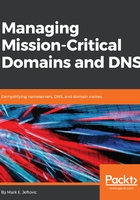
Understanding the domain name expiry cycle
Registration terms typically run in one-year cycles. If you register a domain today for one year, it will expire one year from today. The expiration date will be listed in the domain's WHOIS record. (See the previous section, Anatomy of a domain name, and recall that the expiry date listed in the WHOIS record may not be the actual, for-real, expiry date.)
On that day, if you have not renewed your domain via your registrar, the registrar will remove your nameserver delegation out of the TLD and your domain stops resolving.
This is the point at which many people erroneously assume that somebody else can now come in and reregister this expired domain. But this is not the case. Let's plod through this cycle.
The expiry cycle varies between TLDs. Not all TLDs allow or facilitate "parking" as we shortly describe it; some have different "drop" procedures in place. This cycle describes it as it functions for the largest TLDs (.com/.net/.org , for instance) and most of the new gTLDs.